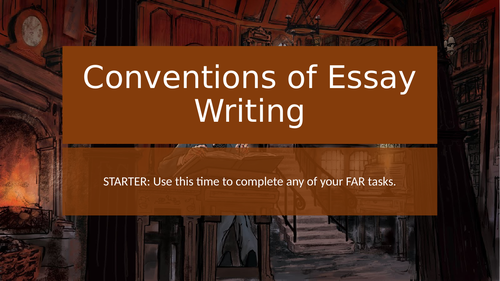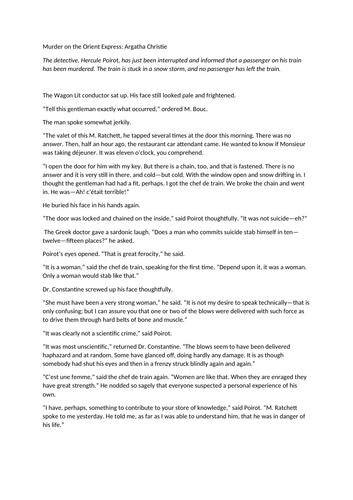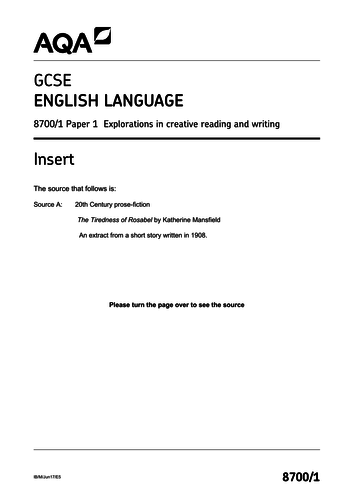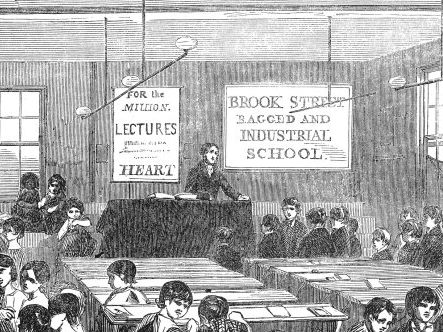
228Uploads
561k+Views
1394k+Downloads
All resources

AQA English Literature: An Inspector Calls essay building lesson
A lesson that models the process of building a high-end An Inspector Calls essay. Please note, the lesson assumes that the class has read the play and has attempted versions of the AQA English Literature questions already. Also, the lesson works best as an aspirational example: I concentrate on using sophisticated language to shape my points, and focus on integrating appropriate references. Please note I’ve deliberately left some academic “gaps” too - this model response is a high-quality response, but there are other avenues of academic insight that can be taken.
Bottom line, to get the most out of this lesson, you’ll need to spend a little time going through it all first - hence the low price.

AQA English Literature Power and Conflict Poetry: Random Comparative Question Generator
Does exactly what it says. This spreadsheet will create one random comparative question for and will generate a new one every time you double-click a cell and press enter. A word of caution in that you cannot retrieve the old question. But, this is very useful for revision and or cover lessons.
I’ve left room for you to add in your own question stems and you can manipulate the poetry lists too. I’ve left some instructions on the relevant tab.
Hope you find this useful.

Universal True or False Spreadsheet/Worksheet Generator
An easy to use spreadsheet where you build a bank of true or false statements (tab 3) which will then create a randomly generated worksheet of ten true or false statements (tab 1). Additionally, an answer sheet will be generated too (tab 2) allowing for the resource to be used in a whole class setting.
All you need to do is populate the spreadsheet with true/false statements and then identify which statements are true, and which are false.
Instructions are built into the spreadsheet itself.

AQA English Literature Poetry Knowledge Tracker Spreadsheet
A useful little tool. It allows you to RAGB(red, amber, green, blue) your students understanding/annotations of the 15 Power and Conflict poems in the AQA anthology. Also, it provides you with a poem by poem breakdown of your classes understanding/quality of annotations so you can see where the gaps are all the clearer.
The spreadsheet is set up for a class of up to 40, but the coding can easily be altered to allow for a whole year group.

AQA English Language P2: Glastonbury vs Greenwich
A simple power-point designed to be used either AFTER a class has sat the AQA English Language Paper 2 Specimen Paper 2, or as part of a walking-mock style lesson where the students mark their work immediately afterwards. It’s cheap because I’ve essentially deposited the contents of the mark criteria on to the power point in such a way that the students can use it it to peer or self-assess. The resource JUST contains the power point.

AQA English Language Paper 1: Glass, Bricks and Dust
Two powerpoints, both showing the same thing, but one is designed to be used on a mobile phone (portrait, no animations etc.).
The powerpoint can be used one of two ways. Either it can be used as part of a talking mock exam (where the students talk through a strategy before attempting each task, followed by marking and reflective targets) or as part of getting the students to evaluate their own efforts with a view to setting individual targets.
Model material is included as well as the source itself (along with the appropriate mark scheme).
The only thing this doesn’t “mark” is the AO5 element of Question 5. But everything else is there.

AQA English Language P2: Section B (using A Christmas Carol)
A series of lessons designed to make sure students have a clear understanding of the “basics” and the “developed” skills and techniques required for EACH of the possible text types they could meet in Section B of the English Language Paper 2 exam. Because my lot were taught A Christmas Carol (and I was trying to kill two birds with one stone by revising this at the same time…), the tasks are all focused on writing within the world of Scrooge. To that end, they may require some editing on the part of the user - hence the reduced price.

KS3: Murder on The Orient Express Language Task - Method Focus
Using a format that proved successful in the KS4 arena, I’ve adapted the thinking to apply to an AQA English Language P1 Q2/P2 Q3 style task that would fit for a higher ability top set KS3 class.
The approach is to initially read the extract then to specifically identify concepts that relate to a language focused task, followed be explicitly identifying language based methods and incorporating into a response.

KS3: Born a Crime - Structure Focus
A lesson take from a collaborative scheme of work. The lesson focuses on the quite excellent Born A Crime by Trevor Noah. The focus is developing an initial understanding of South Africa, then Trevor Noah himself, before focusing in on the context surrounding the story itself.
After, the focus switches to analysing the structural choices made in the extract.
Additionally, I’ve included a useful little follow up lesson where the focus ins to build a piece of creative writing that follows a specific structural path.

AQA English Literature: Romeo and Juliet Method Focus Essay Builder
Similar to a lesson I posted on A Christmas Carol. After a bit of a warm-up, the crux of the lesson is focused on establishing concepts then explicitly showing students HOW to identify methods - again, some still confuse quotations and methods - before pointing them at an exam question.
UPDATE: I repeated this lesson a few weeks later with a different extract, but backing off a notch in terms of explicitly identifying methods.

AQA English Literature: A Christmas Carol Method Focus Essay Builder
My year 11s were STILL struggling with how to frame a method, so I came up with this stand alone lesson. The idea is that, having reviewed the slide where the methods are explicitly identified, the students will see that a method and a quotation are not the same thing.
This was a successful lesson.
UPDATE: I repeated this process with a bottom set year 10 class where I was even more specific. This was also a successful lesson, so I’ve included it.

AQA English Language Paper 2 Deconstruction: The Crossing vs. Idle Days in Patagonia
This resource was designed to be used after a class or cohort have sat the 2019 English Language paper 2. It’s set up to be used after a class has sat the exam and had their papers marked, but it wouldn’t take much modification to be used as part of a scenario where the students get the material, execute a preparatory strategy, answer the question and then peer/self mark.
The material from the AQA mark scheme has been integrated into the PowerPoint, so students can get a sense of what level their response is before fine marking. I’ve done a few in this style and the students value them as revision tools too.

AQA English Language Paper 2: Death Zone vs London Snow
A powerpoint lesson designed to be taught either AFTER a class has sat AQA English Language Specimen Paper 4, or to be used WHILST a class is sitting the same paper in the form of a mock exam where feedback is given immediately.
In this powerpoint, I refer directly to the model material provided by AQA and provide some feedback that can be given to the students. The idea with the feedback is that the person marking (teacher or student) writes down the letter/number and, when the marked work is returned, the owner of the response can either write the target down in full or highlight it in a printed version.

AQA English Language Paper 1: The Mill
A PowerPoint designed to be used after students have sat the Section A of the AQA English Language Paper 1 for June 2019. It wouldn’t take much altering to be used as a mock exam itself. The slides are set up to show the model answers from the mark scheme so that students can peer/self assess and give actions and feedback.

AQA English Language Paper 1: Brighton Rock
A deconstruction of the English Language Paper 1 examination that uses Brighton Rock as a source. I’ve lifted the model material from the mark schemes and there’s FAR related targets included. Essentially, this is a lesson that can be taught either AFTER the students have sat the exam and you want them to peer/self assess, or you could change it so that that they answer a question and then mark their efforts.
The Section B element is a bit of an experiment - peer marking creative writing is always a challenge. So I’ve given the students a series of yes/not/some related questions. The idea is that they “tick” the level next to the answer on a copy of the AO5 and AO6 mark schemes. Using that, they should be better able to work out where the creative writing fits. My peer marked creative writing has got much more accurate as a result of this.

AQA English Language Paper 1: The Tiredness of Rosabel exam deconstruction
A lesson designed to be taught AFTER the class has sat a mock exam. However, with very little modifcation this can become a walking-talking mock exam, or a peer/self assessment based lesson.
The powerpoint contains model material and an indicator as to the quality of the model material. My class found this lesson to be very useful.
Additionally, the insert is available for free should you wish to download it for yourself. I include the link below:
https://linwood.bournemouth.sch.uk/summerwood/files/2017/12/8700_1-INS-EnglishLanguage-G-6Jun17-AM.pdf

AQA English Language Paper 2 Deconstruction: The Other Side of the Dale vs The Ragged School
I’ve done quite a few of these now, and I always try to improve on the last one. I think this is about as far as I can go with this format. Here’s what you get:
An individual breakdown of each of the exam questions. Each section contains the following:
A breakdown of the AQA related material
A walk-through for Q2, Q3 and Q4
Suggested targets and strategies
5 Case studies using real student responses (Except for Q1. You’ve got 10 for Q5 though)
Real students planning processes laid out for discussion
It’s a big one - you’ve got 60+ slides to work through. In terms of teaching, this works best after you’ve sat the relevant exam. However, it wouldn’t take much tweaking for a mock-style scenario. Also, this is designed to be given to the students so that they can engage with it at home.

AQA English Language Paper 1 Deconstruction: The Silent Land
Similar to a number of other resources I’ve already posted.
Designed to be used after the students have sat the associated AQA English Language Paper 1 GCSE Paper, though with a little tinkering, you could run this as a mock exam itself and then have the students peer/self-assess afterwards.
The powerpoint goes through each of the five questions, placing a firm expectation on the students having a pre-established strategy for completing each task. The students are then encouraged to refine this strategy. Each of the sections contains a break down of the associated source, exploration of the stepped Model Responses provided by AQA, and then provides the students with up to FIVE Case Study responses written by students (containing mistakes and all).
I’ve had a lot of success with these types of powerpoints and they are especially useful for students working in isolation, or as a revision tool.
Hopefully this will be of use to you.

Head of Year/College Central Spreadsheet
I designed this spreadsheet to track a bunch of the elements I needed to keep an eye on within the Head of Year role. Remember, hide the columns you don’t need and write comments to keep a fuller track of details. A watered-down version of each area is available to see on the top sheet. Also, you can add/modify the menus The areas are as follows:
CONTACT TRACKER: Designed to keep track of meetings and phone calls from class room teacher all the way up to governors.
TARGET TRACKER: Similar to contact tracker but it allows for you to track a set of targets. I’d log the target in a comment and then enter a new target should I need to do so.
OUTSIDE AGENCIES TRACKER: The original reason I set the spreadsheet up. Allows for you to see who has interactions with an agency (e.g. Early Help) and track your contact with them.
BULLYING/INCIDENT TRACKER: Accounts for identification of incident, investigation and follow up. You can then log the action.
TOILET/TIME OUT PASS TRACKER: Allows for you to monitor when a pass was set up and keep a check of how frequent it is used.
You’ll need to copy some of the sections to expand. Not a spreadsheet for the faint hearted, but you’ll only ever need THIS spreadsheet.
EDIT: Hello. I’ve included an updated version of this spreadsheet. I’ve used it over the year and, whilst I have found it to be REALLY useful, there were some issues with ordering things and the information becoming corrupt. So, I’ve made a new one that uses the students admission numbers as a starting point. The spreadsheet offers the same features as the one above, but with the following additions:
YEAR TRACKER: Tells you clearly how many FSM, PP, Early Help, CIN and many other categories of students you have in one go.
PASTORAL TRACKER: Allows you to track form issues, social issues and a variety of other elements. My intention is to make the spreadsheet available to my Year Team so they can check in on the status of their form members.
More importantly, you can re-order things and it won’t screw up the data.
The spreadsheet is designed to import information from Bromcom on the initial entry page, but it’s easy enough to fill in using other starting points.

AQA A-Level English Language and Literature: Othello - Lesson 3 (Desdemona)
My third lesson. This is designed to be a lesson where I as the teacher give less and the students give more of their own ideas - the group is reluctant to communicate. As a result, it is less "idea heavy" and far more task focused - you'll get a lot of markable material out of this.




















